|
The most popular
theory relating to the origin of the Rising Sun badge, involves the
Trophy of Arms.
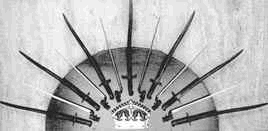 |
The original concept
of the Trophy of Arms belongs to Major Joseph Maria Gordon, of the
South Australian Permanent Artillery. In 1893 he was appointed the first
Commanding Officer of the newly constructed Fort Glanville in Adelaide.
He named the trophy - Australian Rising Sun. |
Major
Gordon's inspiration for the design of the trophy is believed to have
come from the edged weapons radiating from a circle on a badge worn by the
New South Wales Corps. The
badge was an 1800 British universal pattern Shako Plate.
Insert 1. The badge worn by the
New South Wales Corps did not have any edged weapons on it. See
right.
The draftsman
who drew the plan for Major Gordon's Trophy of Arms was Mr. Frank
Bartels, a well known black and white artist from Adelaide. Mr. Bartels
died in 1895.
The
Trophy of Arms consisted of a red semi-circular board on which w as
placed a large brass crown. The crown was protected by an alternating
arrangement of seven cut and thrust sword bayonets and six Martini-Henry
rifle triangular socket bayonets.
Insert
2. Other experts claim that the sword bayonets were actually from
Alexander Henry rifles. Details. |
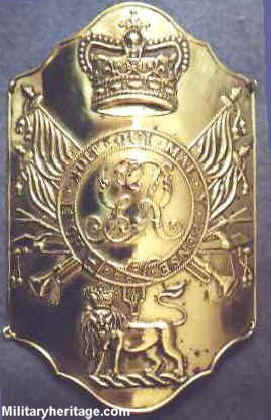 |
Major
Gordon asked Commander William Creswell," who was in command of
HMCS Protector," if the Trophy of Arms could be constructed on
board HMCS Protector by 'Magic', if all the materials were provided.
Magic was the nickname given to the shipwright rating on HMCS
Protector. As the name implied, Magic could produce something out of
nothing. However, Magic was sick at the time and the Trophy was
constructed by another rating who was not a shipwright. Commander
Creswell was not pleased with the result. Major Gordon accepted the
Trophy and never accepted the offer that it could be redone by Magic.
Major
Gordon displayed the Trophy of Arms on an easel in his quarters at Fort
Glanville in South Australia. He took the Trophy with him on recruiting
tours of South Australia. He often told audiences that he had called the
Trophy, 'Australian Rising Sun', as a reply to the Japanese Rising Sun
Flag, because he considered Japan to be a future danger to Australia.
| Insert 3. That is a
bit of a stretch. Japan was an ally at that time and the
"Rising Sun" was a very popular symbol throughout the
new world. The "Rising Sun" had already been used on
several earlier Australian
Colonial badges. |
In
1899 following his promotion Colonel Gordon was involved in the Boer War
in South Africa as a Special Service Officer. He was appointed Staff
Officer for Oversea Colonials. He served as Deputy Adjutant General to
the First Mounted Infantry Brigade, commanded by Major General E.T.H.
Hutton. Colonel Gordon accompanied General Hutton on several
operations during the Boer War. The two men had met In NSW when General
Hutton was re-organising the NSW Military Forces as Commandant between
1893-1896.
After
the Federation of the Australian States on 1st January, 1901, the first
Australian Commonwealth Government appointed Major General Hutton
to be Commander-in-Chief of the Australian Commonwealth Military Forces
from 26th December, 1901. His task was to organise the Military Forces
of the six States of Australia into one Commonwealth Force. General
Hutton arrived in Melbourne on 29th January 1902, to take up his new
appointment.
Following
General Hutton's arrival, Colonel Gordon presented his Trophy of Arms
(Australian Rising Sun) to General Hutton, together with the drawing by Mr.
Bartels.
Major
General Hutton was pleased with the gift. He was made aware of the
history of the Trophy, including its construction aboard HMCS Protector
in Adelaide and he had it mounted above the door of his office in
Victoria Barracks, Melbourne, where he was re-organising Australia's
Military Forces. The Trophy remained there until 1904, when General
Hutton returned to England.
BOER
WAR, 1899-1902
Australian
Boer War Contingents from individual Australian Colonies had been
sailing to South Africa for more than twelve months before Federation in
1901. In March 1901, two months after Federation, the Executive Council
of the Federation took control of the Defence Departments from the
various States." They decided to continue sending Contingents Of
Mounted Rifles to the War, with each Battalion consisting of Squadrons
from the different States.
Eight
Battalions of 'Australian Commonwealth Horse' were raised in 1902 for service
In South Africa. The first four were initially named 1st, 2nd, 3rd, and
4th Battalions 'Australian Commonwealth'," but in April 1902 they were
re-named 'Australian Commonwealth Horse."
Directions
to raise the 5th Battalion Australian Commonwealth Horse were given in
April, 1902. The eight Battalions of ACH were disbanded in 1902 as each
Battalion returned from South Africa.
General
Hutton decided that the Commonwealth Contingents should have a special
badge. Most of the design suggestions from his Staff Officers featured
Australian flora and fauna. However, General Hutton wanted a badge with
a martial theme; he suggested 'something like the Trophy of Arms
that was displayed above his office door. A Melbourne die-sinker was
asked to submit designs based on General Hutton's Trophy of Arms.
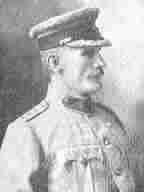 |
The
following letter was sent by the Deputy-Adjutant-General, Colonel John
Hoad (see left) to General Hutton, who was in Sydney at the time preparing for the
despatch of the Commonwealth troops to South Africa.
General Hutton
arrived at Redfern Station, Sydney, on 5th February 1902. The date of
the letter was 6th February 1902: |
"Dear General,
Sketches
of badges enclosed for your consideration. I think they should be half
the size".
(The
first and second sketches became the hat and collar badges of the first
pattern, Australian Commonwealth (Horse).
The third sketch was
the Advance Australian Coat-of-Arms in place of the crown; otherwise
identical to the design of the first and second sketch).
In reply, Hutton
sent Hoad a telegram, dated 7th February 1902 which read:
 |
Re badges;
designs one & two approved. Please carry out in bronze or dark metal
Sir
Edward Hutton.
<<Telegram from
General Hutton to Colonel John Hoad 11 February 1902. |
The
following is a minute, presumably from Colonel Hoad, dated 8th February.
1902
Saw
Deputy Controller of stores and arranged for badges to be made about
half the size. The whole of the badges to be done in 4 days. [Presumably
to be ready for the departure of Second Battalion AC(H) on 12th
February, 1902].
The
first Commonwealth Contingent to sail for South Africa was the Second
Battalion Australian Commonwealth (Horse), which embarked at Melbourne
on 12th February 1902.
These few
surviving 'documents' indicate:
I
.General Hutton approved the badge design for the Australian
Commonwealth (Horse).
2.The
badges would have been ready by 12th or 13th February,1902; five or six
days before the First Battalion, Australian Commonwealth (Horse),
embarked at Sydney for South Africa.
The
First Battalion, Australian Commonwealth (Horse), included a Squadron
from Queensland, which left Brisbane on 26th January, 1902 to travel by
train to join the New South Wales Squadron in Sydney embarking for South
Africa on l8th February 1902. The First Battalion also included a
Squadron from Tasmania, which embarked at Hobart on I 6th February 1902.
It
is believed that the badges would be sent to South Africa on a later
ship, if they were not ready before the First Contingent set sail.
It
has been suggested that the badges were issued before the Queensland
Squadron left Brisbane on 26th January 1902. As this was twelve days
before the badges were approved, the badges could not have been those
approved by General Hutton. However. there is no evidence to prove that
the badges were issued before the Queensland Squadron left Brisbane. In
fact, there is no known evidence to indicate when or where the badges
were issued.
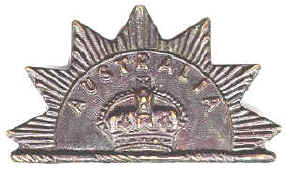 |
RISING
SUN BADGE DESIGN
The
first Rising Sun badge design (see left) is by no means a mirror image of the
Trophy of Arms on which it is thought to be designed. |
The
absence of any documents from the period leaves a great deal to the
imagination regarding the symbolism behind the design. I suggest the
following as possible influences on the die-sinkers design ideas for the
first badge in 1902.
I.
The seven star points of the badge represent the seven cut and thrust
sword bayonets on the Trophy of Arms, which was named Australian Rising
Sun by Major Gordon.
2.
In
1901, a nationwide competition was held to design a National Flag for
Australia. The winning entry is almost identical to the present
Australian Flag, the only difference being that in 1902, the Federation
Star, in the third quarter of the flag (lower left quarter), only had
six points representing the six States of Australia.
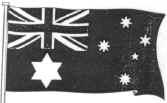 |
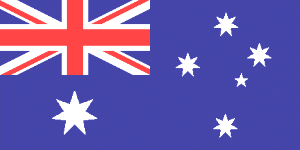 |
 |
| Australian Blue Ensign
1903 |
Australian
Blue Ensign 1908 |
Australian
Red Ensign 1908 |
From
1908 the Federation Star was given a seventh point which represented the
Territories administered by the Commonwealth Parliament. The seven
pointed star on the badge may have been to symbolise the Federation Star
(6 pointed) on the Nation's new flag; the extra point to represent the
seven cut and thrust sword bayonets on the Trophy of Arms.
Insert 5. It is also
easily argued that 7 major and 6 minor rays (total 13 above
vertical) is a practical number of points (1 facing straight up
with 3 on either side and with a minor ray in all the gaps) and that the Federation Star did not have 7
points until 4 years AFTER this badge became obsolete.
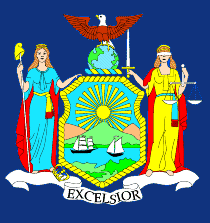 |
- This is the Coat of Arms of New York USA
adopted in 1778 (10 years before Australia was settled).
The "Rising Sun" has the same number of points
(13) above the vertical as the 2nd and subsequent versions of
the Australian 'Rising Sun" badge.
- This indicates that the number of points
is not unusual nor unique to Australia.
|
- The badge of the Westminster Regiment of
Canada which also uses a Rising Sun with 13 points above
the vertical again indicates that a total of 24 points is
visually appealing for a "full sun" and
therefore 13 above the vertical is universally
accepted as the 'correct' number.
|
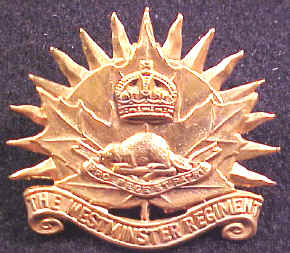 |
As the approval for the Australian
Blue & Red Ensigns were not gazetted until February 1903 it is
not likely that the design had a major bearing on a military badge
designed in 1902. |
The
lines radiating from the centre of the base of the semi-circular first
badge design presumably represent the rays of the sun in keeping with
the title given to the Trophy of Arms Australian Rising Sun.
| Insert 6. It is also
true to say that ALL the sword and cut & thrust bayonets
were originally representing the rays of the sun so ALL the points
were to represent the same thing on the badge. |
A heraldic
wreath forms the base of the badge on which sits the crown. A crown also
sits on the base of the Trophy of Arms. The word AUSTRALIA forms a
semicircle over the crown.
| Insert 7. The AWM
refers to the "heraldic wreath" as a barley twist scroll. |
The
collar badge for this first pattern Rising Sun was identical to the hat
badge only smaller.
| Insert 8. It was
NEARLY identical. Note the difference in the positioning of the word
"Australia". (see below) |
 |
  |
| 1st
pattern hat badge |
1st
pattern collar dogs |
SECOND
PATTERN BADGE
The
second RISING SUN badge design which was also manufactured in 1902 is a
closer representation of the Trophy of Arms. Six short points separate the
seven longer points representing the thirteen bayonets on the Trophy of
Arms. The word AUSTRALIA was changed to AUSTRALIAN and a scroll at the
base of the badge contains the words COMMONWEALTH HORSE.
The
collar badge for this second pattern Rising Sun was voided, i.e. the
metal around the word AUSTRALIA was cut away. It is very similar to the
hat badge design. A heraldic wreath replaces the scroll at the base of
the badge and the word AUSTRALIA replaces AUSTRALIAN around the crown.
WHY TWO DIFFERENT
HAT BADGES FOR AUSTRALIAN COMMONWEALTH TROOPS FOR SOUTH AFRICA IN 1902 ?
The
most common reason given for the change from the 1st pattern badge to
the 2nd pattern badge in 1902, is that the first pattern badge was not
popular. There is no evidence to support this reason. A more plausible
reason for the change of badge, would be the change of name in April
1902, from 'Australian Commonwealth' to 'Australian Commonwealth Horse'.
| Insert 9. It can also be
argued that the first badge was produced in a rush and did not
accurately indicate the Unit name. Therefore, when time allowed a better
option was chosen. The word "Australia" indicated a whole
country and in the absence of any other insignia was misleading. The
words "Australian Commonwealth Horse" were much more precise
and military.
It can be further argued that the
second version much more closely resembled the original concept and therefore
version 1 was seen by the people at the time as a stop gap measure
created in haste and with the intention of replacing it as soon as time and
money permitted.
|
|